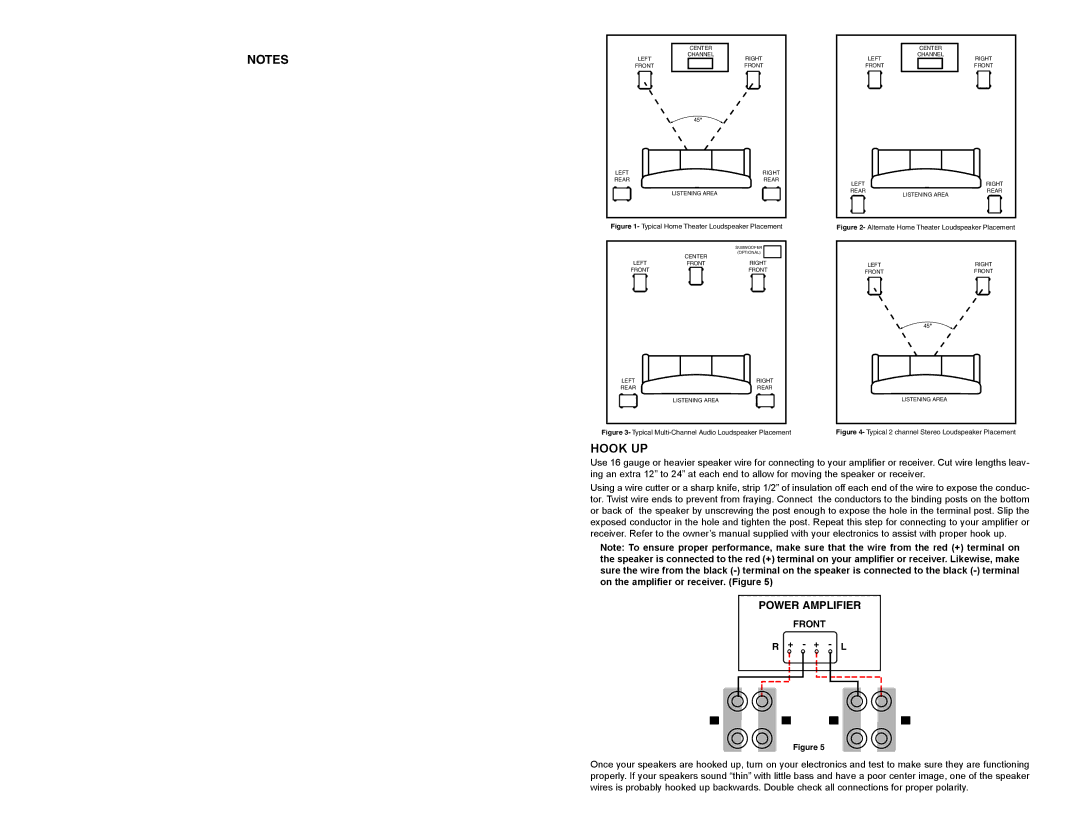
NOTES
LEFT
FRONT
CENTER |
|
|
CHANNEL | RIGHT | LEFT |
| ||
| FRONT | FRONT |
45 |
|
|
CENTER
CHANNEL
RIGHT
FRONT
LEFT | RIGHT |
|
|
|
REAR | REAR | LEFT |
| RIGHT |
|
|
| ||
LISTENING AREA |
| REAR | LISTENING AREA | REAR |
|
|
|
Figure 1- Typical Home Theater Loudspeaker Placement | Figure 2- Alternate Home Theater Loudspeaker Placement | |||
|
| SUBWOOFER |
|
|
| CENTER | (OPTIONAL) |
|
|
|
|
|
| |
LEFT | FRONT | RIGHT | LEFT | RIGHT |
FRONT |
| FRONT | FRONT | FRONT |
|
|
|
| 45 |
LEFT | RIGHT |
REAR | REAR |
LISTENING AREA | LISTENING AREA |
Figure 3- Typical | Figure 4- Typical 2 channel Stereo Loudspeaker Placement |
HOOK UP
Use 16 gauge or heavier speaker wire for connecting to your amplifier or receiver. Cut wire lengths leav- ing an extra 12” to 24” at each end to allow for moving the speaker or receiver.
Using a wire cutter or a sharp knife, strip 1/2” of insulation off each end of the wire to expose the conduc- tor. Twist wire ends to prevent from fraying. Connect the conductors to the binding posts on the bottom or back of the speaker by unscrewing the post enough to expose the hole in the terminal post. Slip the exposed conductor in the hole and tighten the post. Repeat this step for connecting to your amplifier or receiver. Refer to the owner’s manual supplied with your electronics to assist with proper hook up.
Note: To ensure proper performance, make sure that the wire from the red (+) terminal on the speaker is connected to the red (+) terminal on your amplifier or receiver. Likewise, make sure the wire from the black
POWER AMPLIFIER
R
FRONT
+ | - | + | - |
L
+
+
+
Figure 5
Once your speakers are hooked up, turn on your electronics and test to make sure they are functioning properly. If your speakers sound “thin” with little bass and have a poor center image, one of the speaker wires is probably hooked up backwards. Double check all connections for proper polarity.
